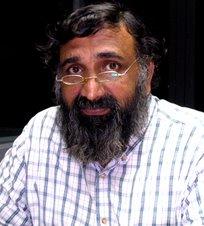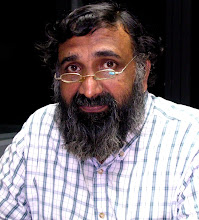LFY: We understand that your company River Valley Technologies is doing business using TEX. How did you happen to become acquainted with TEX?
CVR: I started learning TEX to escape from the hardships of a motor neuron disease that afflicted me when I was 25. I working at the Kariyavattom campus of the of Kerala. In the evenings, students used come to me for help in preparing documents including, theses and reports. It was at that time that K.S.S. Nambooripad of the Department of came back from the United States with a of floppy disks containing TEX/LTEX, which hehis students to learn and use. That was also learned about TEX. Prof. Nambooripad also me to learn the TEX language since it would fit well into my scheme of things. A detailed account is provided at http://www.tug.org/interviews/-files/river-valley.html.
LFY: When was this?
CVR: This was in the late eighties.
LFY: How did you happen to start River Valley Technologies?
CVR: TEX interested me. Since I had abundant free time, I learned this classic text-processing language, and also started exploring the possibilities of making a living out of it. Surprisingly, I had a large quantum of text-processing work from the university, which I couldn’t single-handed. On the other hand, I was not enough to run a full-ûedged company on a commercial scale, nor had the entrepreneurial skills do so. However, when the pressure of work and the demand for services escalated, I decided to open up a company along with my two younger brothers (Rajendran and Rajagopal). Thus River Valley Technologies came into existence on the premises the Software Technology Park (STP) in Trivandrum on the New Year of 1994.
LFY: Were you using Free Software at that time?
CVR: No. I did not know about Free Software at that time. We had a few computers that ran on DOS, and were networked with Novell Netware. We knew about UNIX, which was a much more powerful operating system, but we didn’t have the resources to buy UNIX.
LFY: Then how did you come to use Free Software?
CVR: That was a sheer accident. A young man who used to supply our hardware, once told me that there was something called Linux, which was very similar to UNIX, but was equally good. He also gave me a CD with Linux. We experimented with it. Those were the formative days of Linux and it was very difficult to even install the system. But we eventually did succeed, and replaced DOS and Novell Netware with Linux. From that time onwards, we have never looked back, nor have we used a proprietary operating system.
LFY: Do you remember which distribution it was? Was it the one by PC Quest?
CVR: The first distribution I tried was provided by my ‘hardware friend’—it was Slackware. Our company’s complete switch over to Linux took place with the release of Red Hat Linux 4.0.
LFY: At that time did you know about the philosophy of Free Software, or were you just using it as another kind of UNIX?
CVR: I did not know about the philosophy of Free Software at that time. The only Free Software I knew was TEX. The term ‘free’ meant only ‘gratis’ to me in those days. It was much later that we learned about freedom in software.
LFY: Then how did you come to learn about the philosophy of Free Software?
A: There were two factors that familiarised us with the freedom aspect of Free Software. The first one was the inauguration of the Indian TEX Users Group at Trivandrum in 1998, which brought us closer to many Free Software communities in other parts of the globe. Our acquaintance with several activists like Karl Berry of the TEX Users Group and Sebastian Rahtz of the UK TEX Users Group was instrumental in getting familiarised with the Free Software philosophy.
Second, during the incorporation of FreeDevelopers.Net, a commercial company based in
Washington with proposed branches all over the world, there was a very serious discussion about the Free Software philosophy and its fitness for commercial activities. Rajagopal (River Valley), Anil and Rajkumar (Linuxense), Arun (Space-Kerala) and I—who were instrumental in the formation of the Trivandrum GNU/Linux Users Group—were also very active in the FreeDevelopers.Net, of which Richard Stallman was the chief ethical officer. Needless to say, we gathered enough and more information about all the aspects of Free Software, including its ethical stance.
EFY: How did it happen that your group decided to start an Indian Free Software Foundation?
CVR: That was primarily because of the apparent success of FreeDevelopers.Net in the initial phase and proximity of Richard Stallman for clearing any theoretical doubts. The Indian branch of FreeDevelopers.Net was registered as a commercial company in India under the Companies Act and indeed it was successful in winning a few projects from organizations that favored free software. While we enjoyed the backing of these organizations in the form of projects, we thought it would promote the cause of free software if we had an Indian chapter of Free Software Foundation. The idea was deliberated at length in the board of FreeDevelopers.Net and as you can imagine, it gained sudden acceptance.
EFY: How did you happen to invite RMS to inaugurate FSF India?
CVR: That was the organic and natural sequel of the events described in my answer to previous question.
EFY: Are you still involved in propagating Free Software? Do you still have links with FSFI?
CVR: Yes and No are the answer. Yes, in the sense that we do fund and maintain http://sarovar.org which is an Indian portal for hosting free software projects, fund several other projects of the TeX Users Group like LuaTeX which is the newest incarnation of Knuth’s TEX that is going to replace the default TEX compiler very soon, and TeX Gyre project which is an ambitious font project of Polish TeX Users Group, contributed fourteen LaTeX packages to Comprehensive TeXArchive Network and still maintain those packages, etc.
However, I am not as active as I was a few years ago. The very reason that brought me into TeX and free software world — perennial muscular dystrophy — has started pulling me back from active life. My mobility is extremely limited, I spend most of my time at home. Of course, Internet is there for my rescue.
LFY: As a person using free software for a decade, do you find any future for free software in business?
CVR: Yes, indeed, I think people can seldom avoid free software no matter it is business or personal computing. In this context, it is worth mentioning a recent development in the text processing world. As you may be aware, most of the text processing companies use 3B2, a proprietary typesetting system for academic journal typesetting. A company namely, Arbortext recently acquired Advent (which owned 3B2); people were a bit scared, but Arbortext came to their rescue saying that they would support and continue 3B2. But within six months, Arbortext was acquired by another CAD/CAM company. The new owners were silent about the continuance of 3B2 system. People are really scared now, and the belief that proprietary systems are more reliable than free/open stuff has vaporized. Some companies have already started development centers for TeX in India which is good news for TeXies and some repented for not using free alternatives. I have had a few requests for consulting too, but declined owing to my own neck-to-neck routines. This incident has opened the eyes of many protagonists of proprietary software in business.
LFY: Can you tell us something about your company? How many people work there? Are you getting sufficient work?
CVR: River Valley Technologies are one of the nine suppliers of Elsevier Science who are world’s largest academic journal publishers. We have been recently adjudged by Elsevier as their number one supplier among the nine for quality, technology and meeting schedules. It is a credit to free software and fitting answer to people who claim that only proprietary software can bring success for companies engaged in commercial grade production. Institute of Physics Publishing, Cambridge University Press and Nature Publishing Group are our other clients in the decreasing order of the size of their accounts with us. We are reasonably popular in the text processing industry where TEX is used and therefore, we do not have any dearth of work. We have a team of slightly over 150 people now and plan to extend our operations to Vietnam with the help of Han The Thanh who is the primary author of pdfTEX and part of our company.
(This work is licensed under the Creative Commons ‘Attribution, No-derivative’ 3.0 Licence. To view a copy of this licence, visit http://creativecommons.org/licenses/by-nd/3.0/)

